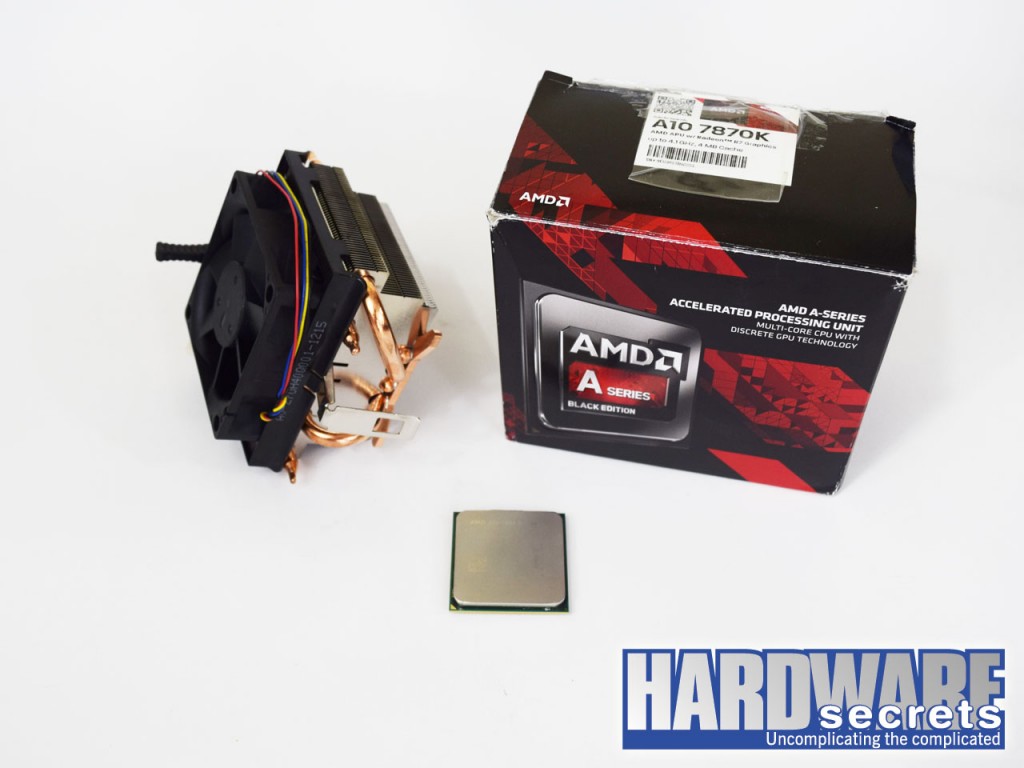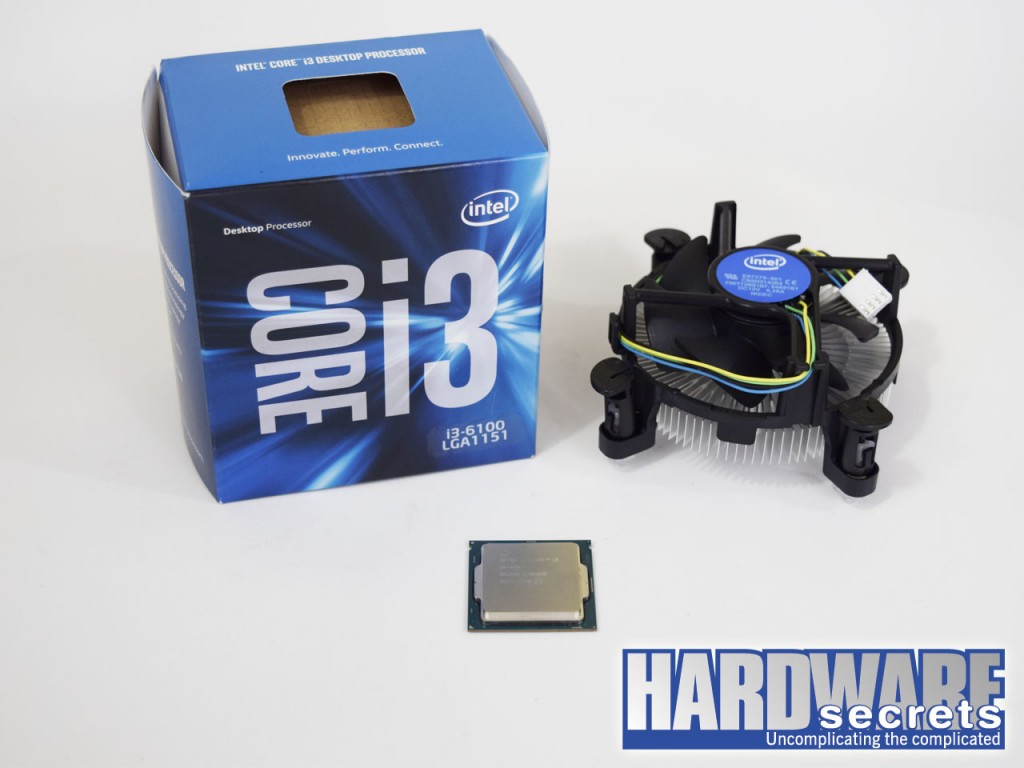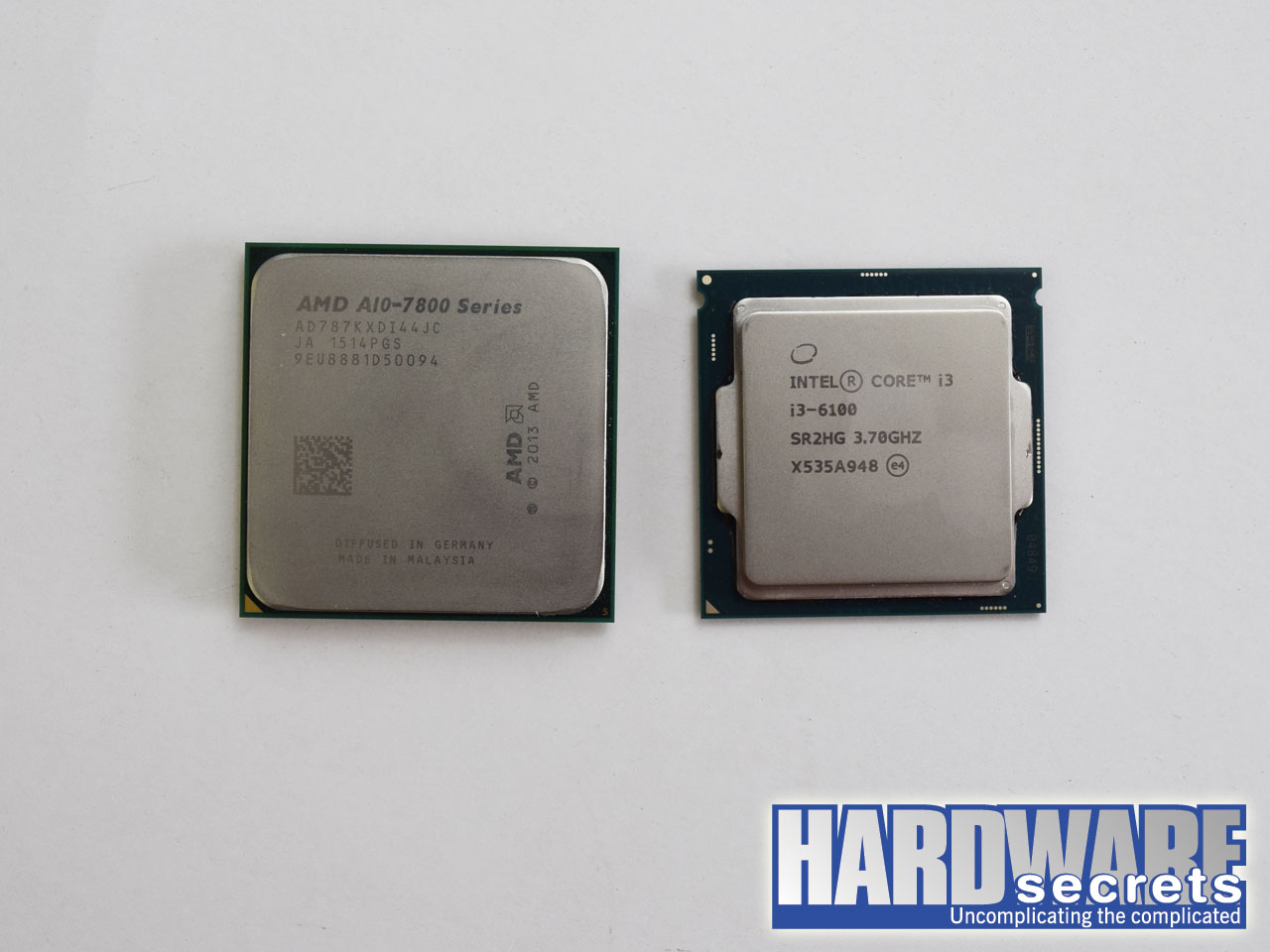[nextpage title=”Introduction”]
Mainstream CPUs are the bestseller models, since they gather more processing power than the value ones and are not as expensive as the high-end models. Today, we will compare two new intermediate processors, the A10-7870K from AMD and the Core i3-6100 “Skylake” from Intel, both them with integrated video. Let’s find out which one is the fastest.
AMD recently launched their new APUs (as they call their processors with integrated video), codenamed “Godavari,” which bring some updates over the “Kaveri” models, but using the same FM2+ socket. The A10-7870K is one of the fastest processors in this family, with four CPU processing cores and an integrated Radeon R7 GPU with 512 cores (divided in eight computing units). Its base clock is 3.9 GHz, with turbo clock up to 4.1 GHz.
Figure 1 unveils the A10-7870K CPU we used in our tests, with its box and stock cooler.
 Figure 1: the A10-7870K processor
Figure 1: the A10-7870K processor
On the other hand, Intel launched recently its new sixth-generation “Core i” processors, codenamed “Skylake”. Those processors are manufactured under 14 nm process, use the new LGA1151 socket, support DDR4 memory (those CPUs also support DDR3 memory, so it is the motherboard that defines the kind of memory to be used) and use the new 9th-gen DirectX 12 GPU.
The Core i3-6100 has two processing cores (recognized as four by the operating system due to the Hyper-Threading technology) and 3.7 GHz clock. It has an HD 530 graphics engine, with 24 execution units and maximum clock of 1.05 GHz. Figure 2 shows the Core i3-6100 with its box and stock cooler.
 Figure 2: the Core i3-6100 processor
Figure 2: the Core i3-6100 processor
In figure 3, you can see both the CPUs tested.
 Figure 3: the A10-7870K (left) and the Core i3-6100 (right)
Figure 3: the A10-7870K (left) and the Core i3-6100 (right)
Let’s compare the main specs of the reviewed CPUs in the next page.
[nextpage title=”The Reviewed CPUs”]
In the tables below, we compare the main features of the CPUs included in our review.
| CPU | Cores | HT | IGP | Internal Clock | Turbo Clock | Core | Tech. | TDP | Socket | Price |
|
A10-7870K |
4 |
No |
Yes |
3.9 GHz |
4.1 GHz |
Godavari |
28 nm |
95 W |
FM2+ |
USD 135 |
|
Core i3-6100 |
2 |
Yes |
Yes |
3.7 GHz |
– |
Skylake |
14 nm |
51 W |
LGA1151 |
USD 130 |
Below you can see the memory configuration for each CPU.
| CPU | L2 Cache | L3 Cache | Memory Support | Memory Channels |
|
A10-7870K |
2 x 2 MiB | – | Up to DDR3-2133 | Two |
|
Core i3-6100 |
2 x 256 kiB |
3 MiB |
Up to DDR4-2133 or DDR3L-1600 |
Two |
Below we have a comparison of the graphic engine of each CPU.
| CPU | GPU | DirectX | Clock | Cores |
|
A10-7870K |
Radeon R7 |
12 | 866 MHz |
512 |
|
Core i3-6100 |
Intel HD 530 |
12 |
350/1,050 MHz |
24 |
[nextpage title=”How We Tested”]
During our benchmarking sessions, we used the configuration listed below. Between our benchmarking sessions, the only variable device was the CPU being tested, besides the motherboard and memory, which had to be replaced to match the different CPUs.
Hardware Configuration
- Motherboard (socket LGA1151): ASRock Fatal1ty Z170 Gaming K6+
- Motherboard (socket FM2+): ASRock FM2A88X Extreme6+
- CPU Cooler: Intel/AMD stock
- Memory (DDR3): 8 GiB DDR3-2133, two G.Skill Ripjaws F3-17000CL9Q-16GBZH 4 GiB memory modules configured at 2,133 MHz
- Memória (DDR4): 8 GiB DDR4-2400 two G.Skill Ripjaws 4 F4-2400C15Q-16GRR 4 GiB memory modules configured at 2133 MHz
- Boot drive: Kingston HyperX Savage 480 GB
- Video Card: integrated
- Video Monitor: Philips 236VL
- Power Supply: Corsair CX500M
Operating System Configuration
- Windows 7 Home Premium 64-bit
- NTFS
- Video resolution: 1920 x 1080 60 Hz
Driver Versions
- AMD driver version: 15.11
- Intel Inf chipset driver version: 10.0
Software Used
- 3DMark 1.5.915
- Adobe Photoshop CC + Retouch Artist Speed Test 1.0
- Cinebench R15
- DivX 10.2.4
- DVD Shrink 3.2
- Media Espresso 6.7
- PCMark 8 2.4.304
- Battlefield 4
- Dirt Rally
- GTA V
Error Margin
We adopted a 4% error margin. Thus, differences below 4% cannot be considered relevant. In other words, products with a performance difference below 4% should be considered as having similar performance.
[nextpage title=”PCMark 8″]
PCMark 8 is a benchmarking software that uses real-world applications to measure the computer performance. We ran three tests: Home, which includes web browsing, writing, light gaming, photo editing, and video chat tests; Creative, that includes web surfing, video editing, group video chat, video conversion, and gaming; and Work, which runs tasks such as writing documents, web browsing, spreadsheets, editing, and video chatting. Let’s see the results.

On the PCMark 8 Home benchmark, the Core i3-6100 was 15% faster than the A10-7870K.


On the Work benchmark, the Core i3-6100 was 21% faster than the A10-7870K.
[nextpage title=”3DMark”]
3DMark is a program with a set of several 3D benchmarks. Sky Diver measures DirectX 11 performance, and is aimed on average computers. The Cloud Gate benchmark measures DirectX 10 performance, and the Ice Storm Extreme measures DirectX 9 performance and is targeted to entry-level computers.

On the Sky Diver benchmark, the A10-7870K was 60% faster than the Core i3-6100.

On the Cloud Gate benchmark, both CPUs had a similar performance.

On Ice Storm Extreme, the A10-7870K was 21% faster than the Core i3-6100.
[nextpage title=”Photoshop CC and Cinebench R15″]
Photoshop CC
The best way to measure the performance of a CPU is by using real programs. The problem, of course, is to create a methodology that offers precise results. For Photoshop CC, we used a script named “Retouch Artist Speed Test,” which applies a series of filters to a standard image and gives the time Photoshop takes to run all of them. The results are given in seconds, so the less, the best.

In this test, the Core i3-6100 was 35% faster than the A10-7870K.
Cinebench R15
Cinebench R15 is based on the Cinema 4D software. It is very useful to measure the performance gain obtained by the presence of several processing cores while rendering heavy 3D images. Rendering is an area where a bigger number of cores helps a lot, because usually this kind of software recognize several processors (Cinebench R15, for example, can use up to 256 processing cores).
We ran the CPU benchmark, which renders a complex image using all the processing cores (real and virtual) to speed up the process. The result is given as a score.

Here, the Core i3-6100 was 21% faster than the A10-7870K.
[nextpage title=”Video encoding”]
DivX
We used the DivX converter, a tool included in the DivX package, in order to measure the encoding performance using this codec. The DivX codec is capable of recognizing and using all available cores and the SSE4 instruction set.
We converted a Full HD, six-minute long .mov video file into an .avi file, using the “HD 1080p” output profile. The results below are given in seconds, so the lower the better.

On DivX encoding, the Core i3-6100 was 21% faster than the A10-7870K.
DVDShrink
DVDShrink is an old but still very useful program to “shrink” video DVDs that have more than 4.7 GiB of data to fit single-layer DVD media. We used it to compress the DVD of “The Lord of the Rings: The Fellowship of the Ring” DVD to 4.7 GiB. The results below are given in seconds, so the lower the better.

On this test, both processors had the same performance.
Media Espresso
Media Espresso is a video conversion program that uses the graphics processing unit of the video engine to speed up the conversion process. We converted a 1 GiB, 1920x1080i, 23,738 kbps, .mov video file to a smaller 320×200, H.264, .MP4 file for viewing on a smartphone. The results below are given in seconds, so the lower the better.

Here the Core i3-6100 was 25% faster than the A10-7870K.
[nextpage title=”Gaming Performance”]
Battlefield 4
Battlefield 4 is the latest installment in the Battlefield franchise, released in 2013. It is based on the Frostbite 3 engine, which is DirectX 11. In order to measure performance using this game, we walked our way through the first mission, measuring the number of frames per second three times using FRAPS. We ran this game at 1280 x 720, setting overall image quality at “low.”
The results below are expressed in frames per second (fps) and they are the mean between the three collected results.

On Battlefield 4, the A10-7870K was 60% faster than the Core i3-6100.
Dirt Rally
Dirt Rally is an off-road racing game released in April 2015, using Ego engine. To measure performance using this game, we ran the performance test included in the game, in 1920 x 1080 (Full HD) resolution and image quality configured as “low” and MSAA off.
The results below are expressed in frames per second (fps).

In this game, the A10-7870K was 44% faster than the Core i3-6100.
Grand Theft Auto V
Grand Theft Auto V, or simply GTA V, is an open-world action game released for PCs in April of 2015, using the RAGE engine. In order to measure the performance on this game, we ran the performance test of the game, measuring the framerate with FRAPS. We ran GTA V at 1280 x 720, with image quality set to the minimum.
The results below are expressed in frames per second.

On GTA V, the A10-7870K was 41% faster than the Core i3-6100.
[nextpage title=”Conclusions”]
Both the main CPU manufacturers are, by now, offering products with different trajectories. While Intel launches a new CPU based on a new microarchitecture and socket, AMD have not launched a new platform for years, which is frustrating to the enthusiasts.
However, the results we found on this review are the same we saw on the A8-7670K CPU Review and on the A10-6800K vs. Core i3-4150 CPU Review: the Core i3-6100 has a little higher performance on tests that depends exclusively of the CPU performance, but the A10-7870K has a faster GPU than its competitor.
So, the choice for the “best” processor will depend on how you plan to use it: if you do not intend to use your computer to play games, or if you will use a dedicated video card and disable the integrated video, the Core i3-6100 is a best option than the A10-7870K. But if you want to build a budget gaming computer using only the integrated video (or if you want to use a low-end AMD video card taking advantage of the AMD Dual Graphics Technology, were the processing power of the video card adds to the integrated GPU), the A10-7870K is a better deal.

Leave a Reply